Here it goes . . . the “agony and ecstasy” of yoga after hip replacement. For the first couple of months post-op, I tracked my progress in a journal. What follows is my personal experience. Yours will certainly be different. Each body has its unique quirks. But for everyone most definitely, the flexibility and strength you have beforehand will make a big difference in what you will be able to do afterwards, and that is your measure. At just over one year post-op, I can do about 85 – 90% of what I did before my hips got bad. I’m getting better all the time too, and feeling very, very grateful!
The type of surgery you have also makes a difference. My surgery was anterior, done in France by Dr. Frédéric Laude, both hips at the same time. I highly recommend this approach. But do your homework and make sure you get a surgeon with lots of experience, because extra skill and training are required. In this method, the muscles are separated, not cut, and the access is all through one small incision (about 5 – 7 cm) in front. The “two-incision” anterior method is not the same thing! Dr. Laude has an excellent explanation of the various surgical techniques on his website, as well as a detailed description of his preferred method of the anterior approach.
Flexibility came back to me quickly after the surgery. Strength was another story! My muscles were not firing as usual, not coordinated, and very weak. Even though they had not been cut, they were traumatised. The big focus for me in recovery has been building strength. Intuition tells me this is important for everyone. Strong muscles make the joint stable!
Even now just a year after surgery, my strength is still improving. I work on it every day, and it feels fabulous. It builds a solid ground, and from that I feel the courage to go for more and more in my practice.
First Two Months
This was the time I needed to be careful. I was told to avoid extension from the hip (so no back bends) and twisting across the standing leg (so no poses like Reverse Trikonasana). Other than that, I could do anything that felt O.K. Sports were contraindicated for the first two months. I took that guideline to apply to extreme yoga as well.
Dr. Laude recommended indoor cycling, so I rented a bike for the house and went on it for about 10 minutes, three times a day. (Very boring, but I believe it helped get those muscles working again.)
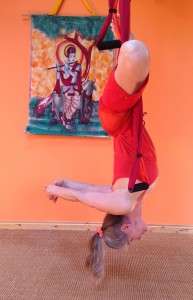 For once in my life, I carefully obeyed all the rules!!! Since I’d been on crutches for nearly a year, doing anything felt wonderful. It was easy to follow the restrictions because I had so many other things to work on. I loved my little yoga practice, and particularly loved the way I felt myself improving daily (unlike before the surgery when I was getting worse and worse!)
For once in my life, I carefully obeyed all the rules!!! Since I’d been on crutches for nearly a year, doing anything felt wonderful. It was easy to follow the restrictions because I had so many other things to work on. I loved my little yoga practice, and particularly loved the way I felt myself improving daily (unlike before the surgery when I was getting worse and worse!)
For the first 10 days or so after surgery, I did very little. This, roughly, was my practice:
1. Hanging on my yoga trapeze, starting with legs parallel and then gradually turned out in Baddha Konasana position. (A yoga trapeze is fabulous! Highly recommended. It was wonderful for stretching out my back when my hips were the worst and I could do little else. I love it now for all kinds of anti-gravity poses.)
2. Shoulder-stand, Down-dog, Navasana (My legs trembled in this one! My muscles were so weak; I could barely hold it.)
3. Leg lifts lying on my back: This was the beginning of strength work. It was really, really hard at first. I could not lift those feet off the floor!!! I’d think move, but nothing budged! Finally, with persistence, I got them up a centimetre. I practised these on my side too, for adduction and abduction (but not on my tummy because extension was not allowed).
4. Supported squat (holding onto a chair).
Over the next couple of weeks, I added in basic seated poses.
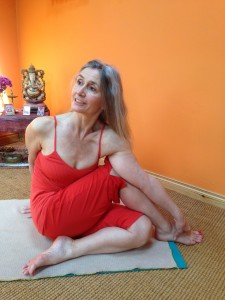 I felt really stiff at first. Forward bending had always been so easy for me, but now I understood the feeling of resistance! Creaking like the Tin Man from OZ, I eased my way into those forward bends and twists, slowly and with lots of breath. My back was screaming with the release, but it felt divine too! Every day, the release increased, and after a few weeks I could go fully into these poses:
I felt really stiff at first. Forward bending had always been so easy for me, but now I understood the feeling of resistance! Creaking like the Tin Man from OZ, I eased my way into those forward bends and twists, slowly and with lots of breath. My back was screaming with the release, but it felt divine too! Every day, the release increased, and after a few weeks I could go fully into these poses:
Pascimottanasana, Janu Sirsasana, Ardha Baddha Padma Pascimottanasana, Marichyasana A;
Easy versions of Marichyasana C and Ardha Matsyendrasana;
Shoulder stand variations: Halasana, Karnapidasana, Supta Konasana, Baddha Konasana and Upavista Konasana.
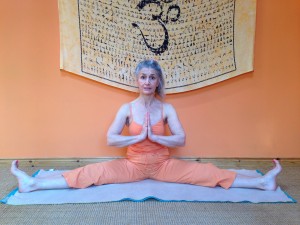 Twenty-one days after surgery I crossed into full lotus for the first time, though I could only hold it a few seconds. (Now I can sit comfortably in lotus for a half hour.)Â I did headstand against the wall. Very creaky but I got up there. (Never fully understood before how much strength is necessary for a stable headstand.)Â With the guidelines in mind, I did no back bending poses where the hips were at all involved. All I did was Cobra, keeping the pelvis firmly on the floor and the hips neutral.
Twenty-one days after surgery I crossed into full lotus for the first time, though I could only hold it a few seconds. (Now I can sit comfortably in lotus for a half hour.)Â I did headstand against the wall. Very creaky but I got up there. (Never fully understood before how much strength is necessary for a stable headstand.)Â With the guidelines in mind, I did no back bending poses where the hips were at all involved. All I did was Cobra, keeping the pelvis firmly on the floor and the hips neutral.
Around One Month After Surgery
I added in Marichyasana B and Parivrtta Janu Sirsasana. Twists were getting deeper. I was binding my hands, but not tightly. I added in Marichyasana D, so hard at first, but it felt delicious in the back to twist that deeply again!
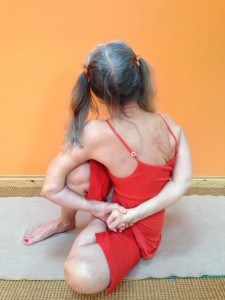 Because I had been on crutches so long before surgery, my leg muscles needed to learn how to walk again. For that reason, standing poses were not possible for me before one month. Otherwise, I would have started with them immediately. They are foundational to yoga, and really important for building strength.
Because I had been on crutches so long before surgery, my leg muscles needed to learn how to walk again. For that reason, standing poses were not possible for me before one month. Otherwise, I would have started with them immediately. They are foundational to yoga, and really important for building strength.
In ordinary life, I still could not squat down without holding onto something, though I was beginning to walk without crutches. What I needed was strength! It was time to begin standing poses and Surya Namaskar (Sun Salutations).
Everything started out modified (Trikonasana, hand to the calf, Parsvakonasana, arm on knee). But in a couple of weeks, my hand was going easily to the floor. With Reverse Parsvakonasana and Reverse Trikonasana, I held back, maintaining very simple modified versions because of the precautions. It was the same with Surya Namaskar. I avoided the leg going back into a lunge, which would extend the hip. I placed it into an upright kneeling position instead.
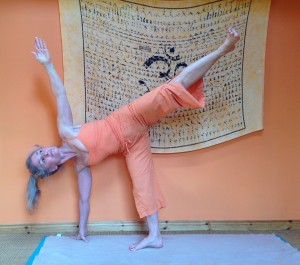 I added in standing balancing poses: Ardha Chandrasana, Uttihita Hasta Padangusthasana, Vrksasana. To begin with, I needed to hold the wall for balance. But these poses are wonderful for building strength. Tree pose in particular I loved, so empowering to feel that stability on one leg returning. I used the wall like a ballet barre, letting go then coming back to it.
I added in standing balancing poses: Ardha Chandrasana, Uttihita Hasta Padangusthasana, Vrksasana. To begin with, I needed to hold the wall for balance. But these poses are wonderful for building strength. Tree pose in particular I loved, so empowering to feel that stability on one leg returning. I used the wall like a ballet barre, letting go then coming back to it.
Two Months After Surgery
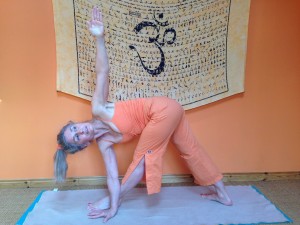 This next month, I could test the waters a bit further. No more precautions . . . so how far could I go??? Slowly and cautiously, I ventured into what had been the danger zone. Reverse Trikonasana??? Felt fine, my hand went to the floor no problem. Reverse Parsvakonasana??? Bit dodgy, kept my hands in namaste, that floor was still not accessible. Simple backbends??? All O.K., felt divine to open into the back! Surya Namaskar??? Back into the flow!
This next month, I could test the waters a bit further. No more precautions . . . so how far could I go??? Slowly and cautiously, I ventured into what had been the danger zone. Reverse Trikonasana??? Felt fine, my hand went to the floor no problem. Reverse Parsvakonasana??? Bit dodgy, kept my hands in namaste, that floor was still not accessible. Simple backbends??? All O.K., felt divine to open into the back! Surya Namaskar??? Back into the flow!
So now I was also doing:
1. Leg lifts on my tummy. (These are great for glut strengthening. Once I started these, walking really improved, both in terms of ease and stamina.) I did single leg lifts, then Salabhasana, basic variations.
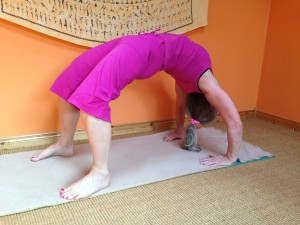 2. Back bends. Dhanurasana, Ustrasana, Setu Bandhasana, and finally Urdhva Dhanurasana!!! (Ah, that felt fabulous!) But I was careful here, never pushing past what came very easily.
2. Back bends. Dhanurasana, Ustrasana, Setu Bandhasana, and finally Urdhva Dhanurasana!!! (Ah, that felt fabulous!) But I was careful here, never pushing past what came very easily.
3. More standing balancing poses. Virabhadrasana III, Natarajasana, and going forward to the floor in standing half-lotus. (This took some time to get back, strength once again the issue.)
4. Headstand in the centre. (I could do it, but it felt wobbly and precarious. It’s been really interesting to watch headstand progress. As strength returned in other ways, so did that old feeling of the legs floating up into a solid, stable headstand. But it took awhile!)
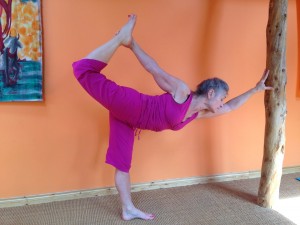 5. I tried to kick up into a handstand at this stage. Disastrous!!!! Not a-happening! I left it alone and focused on strength building with leg lifts, standing poses and balancing poses.
5. I tried to kick up into a handstand at this stage. Disastrous!!!! Not a-happening! I left it alone and focused on strength building with leg lifts, standing poses and balancing poses.
6. I started to work with a thera-band at this point too, doing hip strengthening exercises for adduction, abduction, flexion and extension. All this was really helpful!
Three to Six Months After Surgery
After a month of cautious back bending, it felt O.K. to go deeper. With breath and attention, I deepened into more hip extension. Felt fine! My practice was stabilising. It felt great just to consolidate with where I was, holding poses longer, feeling them deepen, feeling strength and stability and stamina building. Leg lifts on the floor continued, along with a whole sequence I do for hip opening/strengthening.
In terms of the debate over “hip-opening”, I have heard it said that hips are bones, not meant to be opened. I am not of that point of view. It is not the bones that are “opened” anyway; it is the soft tissues, particularly the fascia that holds the muscles in place. The hip joint is naturally capable of a great range of motion. But with increased flexibility, increased strength is also necessary. It is strength that keeps the joint safe through its range of motion.
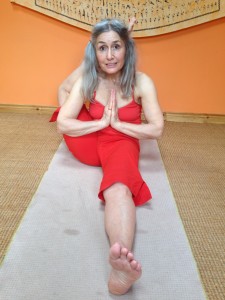 Ballet training naturally develops strength along with flexibility. Yogis need to ensure that their practice does something similar. The floor hip sequence I do involves the application of resistance in all the various ways the hip can move. With the leg held in a stretch, just under its maximum potential, I apply counter resistance for about 20-30 seconds. Release and repeat. In this way, flexibility improves safely, along with the strength necessary to keep things stable.
Ballet training naturally develops strength along with flexibility. Yogis need to ensure that their practice does something similar. The floor hip sequence I do involves the application of resistance in all the various ways the hip can move. With the leg held in a stretch, just under its maximum potential, I apply counter resistance for about 20-30 seconds. Release and repeat. In this way, flexibility improves safely, along with the strength necessary to keep things stable.
Gradually out of the practice I was doing so far, foot behind the head poses were feeling possible too. I never forced anything. But it felt comfortable getting the right foot behind my head. The left did not go as easily, so I just held it where it wanted to go and breathed into it. The left side has always been the stiffer one.
I was coming up against my natural limitations, and that felt great too. A kind of homecoming!
(For those of you with an ashtanga orientation, at this point I was doing everything in primary except Kurmasana as well as the basic back bending of intermediate. But my practice is not ashtanga any more, and I only do the odd jumping vinyasa.)
Six Months to One Year After Surgery
During this period, I tried more advanced poses, though not every day the same ones. Sometimes I’d just “knock at the door”. Sometimes I’d use props or have someone carefully adjust me into them.
1. Supta Kurmasana, Yoga Nidrasana. Dwi Pada Sirsasana. These strong “foot behind the head” poses never came easily to me. But when my old practice was at its best, they did feel very smooth and open. I used to be able to do the “foot behind the head” section of ashtanga’s second series, complete with all the transitions, quite well.
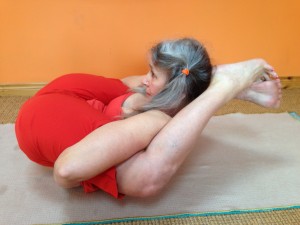 That feels very far off now, particularly the transitions. I believe, for me at least, the wall of limitation is with these transitions. I can actually get into these three poses, though I need assistance in binding and holding my feet. Possibly in time they’ll come on their own. But I go into and out of them slowly, with lots of attention and breath. The quick transitions of ashtanga do not feel like a safe place to go.
That feels very far off now, particularly the transitions. I believe, for me at least, the wall of limitation is with these transitions. I can actually get into these three poses, though I need assistance in binding and holding my feet. Possibly in time they’ll come on their own. But I go into and out of them slowly, with lots of attention and breath. The quick transitions of ashtanga do not feel like a safe place to go.
I wonder how dancers after hip replacement feel about doing grand rond de jambe en l’air or fouetté arabesque (particularly with the sauté)??? Those deep rotations of the hip resemble the quick transitions of ashtanga second series.
2. Kapotasana, Eka Pada Rajakapotasana . . . It feels great to go for these and other stronger backbends. They too never came easily to me. Being on crutches for a year also stiffened up my shoulders. But the limitations I feel are not connected to my hips. It feels fine to work up to the edge here.
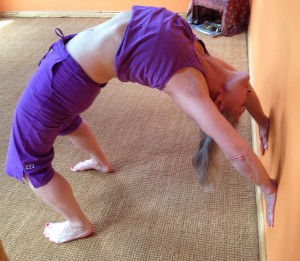 Drop backs are a different matter though. Dropping to the floor into a back bend still feels too scary. I can do it against the wall, reaching about 20 cm from the floor while maintaining good control. It is that last bit of letting go that I don’t want to go into yet, too much gravity exerting pressure into hip extension. However, as more strength comes back into my legs, this too feels like it could be possible again.
Drop backs are a different matter though. Dropping to the floor into a back bend still feels too scary. I can do it against the wall, reaching about 20 cm from the floor while maintaining good control. It is that last bit of letting go that I don’t want to go into yet, too much gravity exerting pressure into hip extension. However, as more strength comes back into my legs, this too feels like it could be possible again.
Just Past One Year
So once again, it is all about strength, strength, and then more strength!!!
This is what I’m working on now.
1. Laghuvajrasana. I do this one lots of times, going down and up slowly, even if not all the way to the floor. First time since the surgery that I tried it, my thighs were screaming for days afterwards! I had not felt muscle soreness like that since my ballet days. It’s a great pose for strength in the quads! (I’m even starting to like it again, which is saying something!) This one will help for drop backs, I believe.
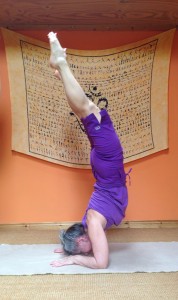 2. Handstands and Pincha Mayurasana. As I said earlier, first time I tried these, the door was shut! I could not kick up for the life of me. In my head was the memory of those legs floating skyward with ease, but the present reality was pathetic: helpless and frustrated donkey kicks! But I persisted. Daily effort paid off. Some days are better than others. It depends on my energy level and what else I’m doing in my practice. Pincha is always easier than handstands. But on a good day, I can kick up into a handstand on both sides. This is definitely a work in progress, and it feels fabulous.
2. Handstands and Pincha Mayurasana. As I said earlier, first time I tried these, the door was shut! I could not kick up for the life of me. In my head was the memory of those legs floating skyward with ease, but the present reality was pathetic: helpless and frustrated donkey kicks! But I persisted. Daily effort paid off. Some days are better than others. It depends on my energy level and what else I’m doing in my practice. Pincha is always easier than handstands. But on a good day, I can kick up into a handstand on both sides. This is definitely a work in progress, and it feels fabulous.
As an exercise, I kick up with one leg and hover over my hands, holding the balance for a few seconds with one leg in the air. I also “bunny hop” up, but I need to lean into the wall to get up into a handstand this way. All this handstand work is great for developing strength and control. My hips are loving it.
Intuition tells me that I’ll feel more secure in drop backs if handstands are coming with ease. (Both involve fear issues.) I’m working hard on them now. After hobbling around on crutches for a year, it feels so empowering to stand on my hands again!
 3. Headstand is finally stable again. I do variations here. Sideways splits, then crossing into lotus, lowering the legs down then up. From headstand I go into Scorpion. This was impossible when I first tried it, but now it is happening again. It is another great one for strength in the hips, legs and thighs (and back too).
3. Headstand is finally stable again. I do variations here. Sideways splits, then crossing into lotus, lowering the legs down then up. From headstand I go into Scorpion. This was impossible when I first tried it, but now it is happening again. It is another great one for strength in the hips, legs and thighs (and back too).
4. Natarajasana: Intuition too led me to a new variation with this pose. Slowly I tip forward, lifting up through the leg and going down to the floor with my hand then slowly back up again (similar to a penchée arabesque). The slow controlled movement in the hip, lifting the leg higher, holding the back and tipping over . . . all this I can really feel developing strength deep in the hip joint. It is not easy and often I lose my balance, but it is coming too. Feels great!
 So all in all, I am happy with my practice. It feels fabulous to be working deeper into poses again, and always with no pain! I am so very, very grateful. Pain had been a part of my practice for so long coming up to the surgery. Truly, I had forgotten what it was like to be without pain.
So all in all, I am happy with my practice. It feels fabulous to be working deeper into poses again, and always with no pain! I am so very, very grateful. Pain had been a part of my practice for so long coming up to the surgery. Truly, I had forgotten what it was like to be without pain.
These days, I don’t think about what I can’t do, because what I can do is so very much, and it is getting better all the time. However, I am aware of the very real limitations that come with age. (I am now 63.) With this too, I’m sure everyone is different. But I know for myself that the pain-free enthusiasm I feel presently is not the same as what I had in my early twenties. Then it was in the ballet studio, and I went full out: pointe work, jumping, stretching to the max, and ready the next day for more! (How I loved to jump!!!)
Now I understand the value of rest to assimilate progress. I feel stiff in the mornings or after sitting for a long time. I need to take care in teaching, demonstrating with caution because I’m not warmed up enough. I intersperse days of light practice into the routine of harder work.
Precautions
Though I won’t ever have the extreme mobility I had when I was younger, I really feel no restrictions from my hips, apart from the following:
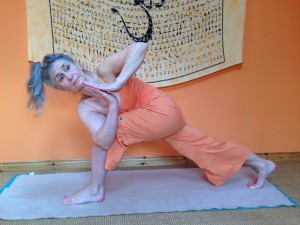 1. Reverse Parsvakonasana – On the right I need to kneel down, place my hand on the floor, then slowly straighten my knee into the pose. I get out of it the same way. Sometimes I just keep the hands in Namaste. The left side is not a problem; I can twist into it from standing. This may be because the ball of my prosthesis is bigger on the left and therefore more stable. The right feels just that bit dodgy so I take extra care with it. On both sides, I keep the back foot turned in, with heel lifted and knee pointed to the floor. (The variation with foot turned out and heel on the floor does not feel good.) With seated twists, I feel no restriction.
1. Reverse Parsvakonasana – On the right I need to kneel down, place my hand on the floor, then slowly straighten my knee into the pose. I get out of it the same way. Sometimes I just keep the hands in Namaste. The left side is not a problem; I can twist into it from standing. This may be because the ball of my prosthesis is bigger on the left and therefore more stable. The right feels just that bit dodgy so I take extra care with it. On both sides, I keep the back foot turned in, with heel lifted and knee pointed to the floor. (The variation with foot turned out and heel on the floor does not feel good.) With seated twists, I feel no restriction.
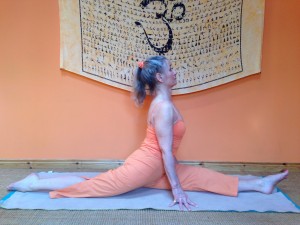 2. Hanumanasana (splits) – Coming out of this, especially turning into sideways splits, I need to be mindful of the right side. I lift up first, decreasing the angle of the splits, before turning in the joint to the other side.
2. Hanumanasana (splits) – Coming out of this, especially turning into sideways splits, I need to be mindful of the right side. I lift up first, decreasing the angle of the splits, before turning in the joint to the other side.
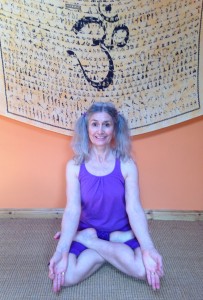 These are little quirks of my own. Yours will be different. Important thing is to listen attentively to your own body. Go forward with prudence but courage too. You will be surprised with all you can do! With the anterior approach, there are no movement restrictions. Though he made no promises about specifics, Dr. Laude said I should be able to do most everything I did before. I am finding that to be very true!
These are little quirks of my own. Yours will be different. Important thing is to listen attentively to your own body. Go forward with prudence but courage too. You will be surprised with all you can do! With the anterior approach, there are no movement restrictions. Though he made no promises about specifics, Dr. Laude said I should be able to do most everything I did before. I am finding that to be very true!
Om Shanti



Wow Marianne, that is so inspiring! It really shows what you can achieve with dedication & practice. Well done.
Thanks, Aideen. Love for the practice has kept me going, even when I literally could not lift my leg 1 cm off the floor! But the great surgeon I got made a big difference too. He understood the needs of dancers, athletes and now yogis. When he said his patients could return to most sports after recovery, even at the professional level, I finally felt some I hope that I’d come out OK on the other side. M x
Marianne wow what an inspiration you are ,such detail ,amazing insight and knowledge,I love you’re ability to turn what could have been a disabling condition into a recovery and a huge amount of information for others.I know it was a difficult journey for you ,I never enjoyed seeing you on crutches but you handled it all with such grace and poise like a ballerina and
A true yogi xxx
Thank you so much, Dee. As you know, it’s been a long road. The support of wonderful friends like you has meant so much to me! You were with me in the early days when my hips were fine. You were with me when I was hobbling around on the crutches. It has been wonderful coming back into action this past year. In all the research I did before surgery, I never really saw a good explanation of what might be possible afterwards in terms of yoga. I hope this can help other people who are feeling similarly lost, confused and depressed about what feels like the permanent ruin of a yoga practice. Not so! Mxxx
Amazing
Dear Marianne,
What a wonderful post and story, so informative and inspiring. I am a long term ashanga practitioner from Cork. I have followed your website a bit over the years. I checked in a month or two ago and I was shocked to hear of your hip story. I also related to it as I have had a lot of knee problems in the past which required surgery, but like yourself I have come out the other side and my practice has stabilised which at the time of injuries i thought would never happen. So it is great to see how you perseverance and hard work has paid off. It is actually quite amazing how much progression you have made in such a short period of time after such invasive surgery. It is great to see one can continue an asana practice after such a procedure, and your blog post is very educational, love it.
Namaste,
Niall.
Thanks so much, Niall. It’s great to hear that you enjoyed this post and other things on my site. I put things out there, but lots of the time never really know what people think. Yes, these past few years have been a big challenge for me. It is amazing to me too how the practice has come back after all I’ve been through. Glad to hear that you too have come through your knee surgeries with renewed vigour in your practice. The body has an incredible power to heal and adapt. My new ceramic hips do have a different feel in certain positions. But this heightens my awareness, creating a new focal point for me to work around. And the whole ordeal heightens my awareness to the ephemerality of the body and everything else in materiality. I’m on borrowed time with these new hips. But the fact is, I was on borrowed time anyway. Everyone is. The practice takes me these days closer and closer to that realisation, and in that way is more powerful than ever.
Om shanti, M
Howdy! I’m at work surfing around your blog from my new iphone 4!
Just wanted to say I love reading through your blog and look forward to
all your posts! Keep up the superb work!